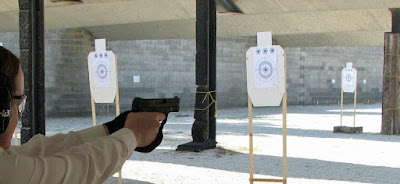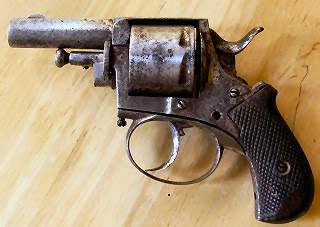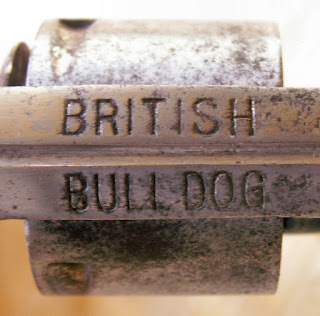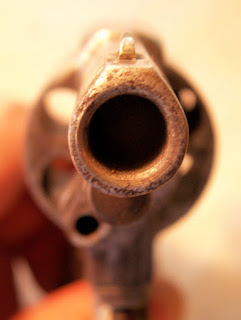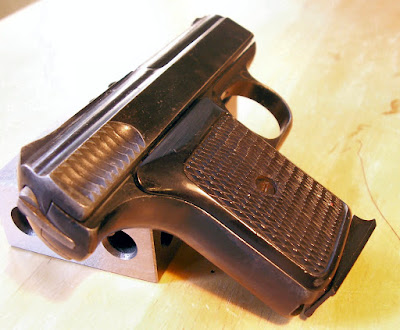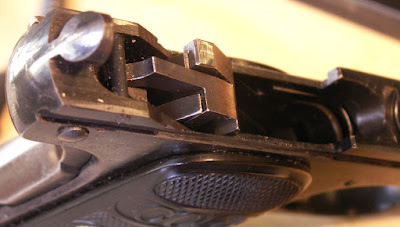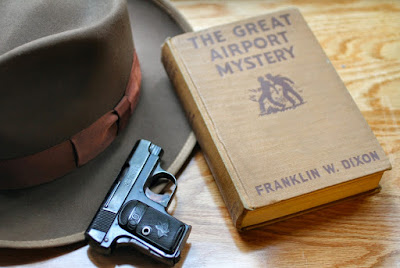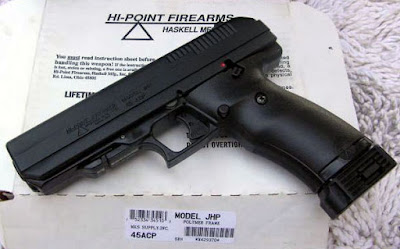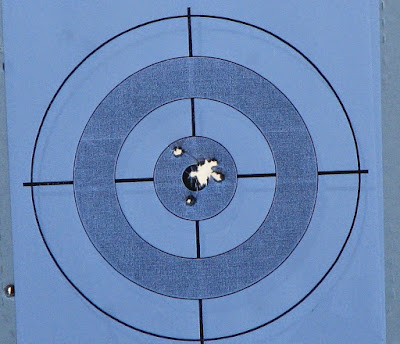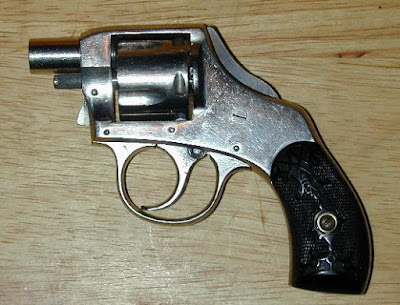Many of those guns are polymer, which makes them both light, and cheaper to make.
I'll be honest. I had never been a fan of guns made out of polymer. But then I added a little Smith and Wesson M and P 9 to the stable after firing one a friend owned and really liked it, and heard the praises of the Glocks from many of my colleagues.
When I saw my first Glock as a young woman back in the late 80's, the 1911 style .45 auto was THE defensive pistol to have when things went south in a hurry. I still felt that way most days, so when one of the Indy gun bloggers first brought one of the smaller Glocks to the range I had to try it.

I wasn't sure what to think. I mean, It's PLASTIC. When I thought of going to a gun show and buying one and coming home with friends asking "what did you get!" all I could think of is the Charlie Brown Halloween special (heavy sigh) "I got a GLOCK". Because frankly folks, to me anyway, most plastic guns have all the aesthetic appeal of a sippy cup. Face it, I love revolvers. I love 1911's I love a gun with some character. I love old weapons, period. I love tools as well. Put a wood handled tool in my hand and I just want to craft something with it or at least take a chunk out of one of my fingers so I can practice some new words in the shop.
But I love such things. Especially guns lovingly crafted with steel and rosewood, intricately machined forgings, polished flats and arcs cleanly intersecting, beautiful bluing and straw tempering, it is hard to find anything in a plastic pistol that speaks to me. Give me something made of fired steel and sweat, to be carried through generations, passed on from father to son, older brother to little sister, mother to daughter.
The history of personal weapons is one of honor, family, sacred duty, prestige and adornment. Warriors were buried with their swords, or they were handed down through generations. I have blades forged hundreds of years ago, as sharp as the day they were made. Somehow a personal weapon with the soul of toaster oven seems wrong. Besides, when you draw that 1911, John Moses Browning is probably looking over your shoulder, smiling.
I wasn't a fan of those first Glocks I fired, only for the feel of the grip than the quality or the handling. But then I got a chance to shoot one of their Glock 21's. It soon made its way to the Range to make a home because frankly, compared to Glock's I'd fired, the 21 was still a barrel of fun but it didn't have that "blocky" feel to the grip I sensed in other models I'd tried with hands which have a small palm, but really long fingers. It now has a custom made laser sight on it, near where I sleep in case of a home break in as I know it won't let me down. But a Glock 21 is not a "budget gun" which is our featured today.
So though I passed on the cheaper Glocks and a Bersa was added to the collection.
 It's a weapon that's been out for a while, and there it was again, for sale at the gun store, at a price I was really surprised at. I picked it up, liked how it felt in my hand and REALLY liked the price. Certainly, there are a lot of small weapons for sale and cheap, but not all are made with good craftsmanship and quality materials. Holding them up, they may look good, but the metals may be poor, zinc or some sort of mystery metal that may be too heavy or too soft, certainly not guns I'd stack up against someone attempting to attack me on an isolated street. I was looking for something for concealed that wasn't just cheap and light, but was made well. Not for a trip to downtown at night, but something small and light that I could carry running errands or in environmental conditions that result in less bulky clothing or as a backup gun.
It's a weapon that's been out for a while, and there it was again, for sale at the gun store, at a price I was really surprised at. I picked it up, liked how it felt in my hand and REALLY liked the price. Certainly, there are a lot of small weapons for sale and cheap, but not all are made with good craftsmanship and quality materials. Holding them up, they may look good, but the metals may be poor, zinc or some sort of mystery metal that may be too heavy or too soft, certainly not guns I'd stack up against someone attempting to attack me on an isolated street. I was looking for something for concealed that wasn't just cheap and light, but was made well. Not for a trip to downtown at night, but something small and light that I could carry running errands or in environmental conditions that result in less bulky clothing or as a backup gun.When I first spotted one, the store owner was quick to point out that this .380 is similar to the Walther PPK/S, including a seven round magazine with a plastic floor plate extension. I did a little homework. On-line reviewers tend to rate them as reliable, well-built, and strong enough for the average "social situation". There are people that want a gun, but aren't into owning more than one or two, or paying a lot of money. So for me at the time, the Bersa was a nice option.
As shooters it's easy to dismiss inexpensive guns as simply being "junk", and all of us wish to own some fine quality firearms. But history has a way of showing that over time, for many an ordinary citizen, a cheap firearm may be all they had to defend themselves with.
On the table sits an old-fashioned revolver, as finely tuned as a musical instrument, carefully tended and cleaned and oiled.It simply sits, no hand upon it, musing, steadfast, not threatening in its form, yet carrying with it a weight of responsibility.The weapon is old, the barrel black, as if fire singed, cauterized by fury and fight, turmoil and threat.It is a weapon of history, of a hand that raised it in response to such things, taking stock of their principals and courage. This is my land, this is my family, these are the things that my hands bled to gain. I may be one man, one woman, but gaunt, tired and undefeated I will take up my arms and not flee.
 I live in a world totally foreign to the original owner of that old revolver, yet I too bear the weary, indomitable outrage against those that feel that they can come in and steal what I have worked so hard for.
I live in a world totally foreign to the original owner of that old revolver, yet I too bear the weary, indomitable outrage against those that feel that they can come in and steal what I have worked so hard for.I wonder what a resident of a 19th Century Western landscape would think of us today were he transported here? For back in the days of the old West, it wasn't just the cowboys and gunfighters that were armed, but the farm and the shopkeeper,
Firearms were prevalent, not only to protect against wild animals, Indian raids and the likebut also against the rustler and the poacher, to whom the laws, gun or otherwise, meant nothing.
But in the later days of the old West, such ordinary folks were unlikely to carry a more pricey six-shooter on their hip. Many of them got a bulldog, and NOT the canine variety
The “British Bulldog” was a basic double action revolver whose design can be traced back to Philip Webley and Son of Birmingham, England in 1872 and were subsequently copied by gunmakers in Continental Europe, particularly in Belgium and the United States
These had a reputation as being good, reliable handguns. It featured a 1.2 inch barrel and was chambered for .44 Short Rimfire. Most of the ones we have seen weren't made by Webley, but by smaller shops where a few gunsmiths with mostly hand tools, could turn simple forgings into function firearms, have them proof stamped, and then send them off to foreign markets by the dozen.
Popular in Britain and the American West, US Army General George Armstrong Custer was said to have carried a pair at the Battle of the Little Bighorn, though it didn' exactly make his day end well.
Intended to be carried in a coat pocket, many have survived to the present day in good condition, having seen little actual use. However, most Belgian copies were not particularly long lived. "Soft parts" wear quickly, which gives way to timing and lockup problems. But that was not an era where people had the ammo to go "plinking" for fun or practice, so such firearms, kept clean and used sparingly, would usually go "bang", not "*#(@!) when necessary. It wouldn't be useful at ranges much beyond a few feet, but many a shopkeeper or bartender kept one under the counter and I guarantee more than one woman of the old West had one nearby when he man was far away from the homestead.
Myself, I prefer a stout looking big barreled big brother - which says more "leave me alone", but too, have a "pocket pistol" when taking the trash out, or walking to the corner store for something quick. Still, back in the day, I don't think I would want to have looked down the shooty end of one of these guns.
Sales of cheap firearms didn't slow down even as the U.S. economy and standard of living increased, paralleling the manufacture of their more pricey counterparts. For every Smith and Wesson high-quality firearm turned out, there would be a budget minded copy made at Harrington and Ricahrdson. Many of those designs were almost identical in looks to their more expensive counterparts the differences being metallurgy and heat treatment, as well as fit and finish.
Pictured is the Range Harrington and Richardson Hammerless .38 S + W.
It was manufactured sometime prior to 1904 I believe, given the caliber and very low serial number and like all first models of the H & R Hammerless, both large and small frames, it was manufactured for black powder cartridge pressures (a give away for that being it doesn't have the caliber stamped on the side of the barrel and there are no horizontal notches on the side of the cylinder).
Like the (Belgian) British bulldogs, they were not likely to hold up well if shot regularly, but they still served a defense function and someone of average means could sav up a few dollars and order one of these from the Sears catalog. Having a function al sidearm compared to NO firearm is a no brainer.
Next up is a little pocket pistol that meetings two functions to qualify as a cheap firearm.
(1) It's a firearm
(2) It's cheap
That's about all of the nice things I can say about it.
The Valor SM-11. These come up occassionally for sale, usually for less than $200, and I've seen one as low as $25 (which screams run away! right there).. This is not one I'd recommend. They usually come in two forms, mint in a box with a box of vintage ammo or parts guns.The owner of this example lost the front of the slide downrange using ordinary factory ammo. The mint ones someone probably bought, shot once, vowing never to fire that particular firearm again, the putting it away for years.
“What’s that?” you say,”Is that pot metal?”
No, it’s probably Zamak, which is way we city folks say high strength pot metal. Apparently. in order to avoid the cost of forging or machining the frame and slide, they were die cast instead. Sure it's cheaper and faster, but Zamack is NOT the best material based on its inherent brittleness and corrosion issues.
The cost cutting didn’t stop there. Compare the internal workings of the SM-11 to the much higher quality Colt 1908 parts. (this is a Range firearm)
The pocket hammerless is another design by firearms legend John Moses Browning. Manufactured by Colts's Manufacturing Company from 1908 to 1948, it was originally said to have been presented to Colt Management before the turn of the century but they passed on it, allegedly in efforts to produce a larger caliber pistol that would help them secure a military contract. Their loss was Frabrique Nationale de Herstal's gain as FN welcomed the design, producing Brownings self-loading pocket pistol and the FN Model 100 both chambered for the Browning introduced .25 ACP (Automatic Colt pistol) cartridge.
The European market fell in love with it, a loss which was felt by Colt as their European sales took a hit. Colt wasted no further time in brokering a deal with Browning and FN to produce the handgun for US sales, marketing it as a small concealable firearm which could be easily tucked into a gentleman's vest pocket for discrete carry
The moving parts in the Colt were milled, heat treated and usually ground to a good finish. Certainly, you don't have to have such a clean finish on EVERY part of a more economical firearm, but when you're looking at parts that keep the gun from firing when it's NOT supposed to do, it's vital they be milled properly and more rugged. Now you may not need to have such a clean finish on every part of a more budget oriented gun,
In the Valor, there are several parts made from stamped sheet metal and a few made of plastic (including the safety, yes, I always think plastic when I think safety) A quick check with a file makes it clear that the steel bits, maybe aside from the barrel, were not heat treated.
The firearm's basic design is not that bad, modeled off of the Walther Patent Model 9, which is a decent little pistol. The Valor is easy to field strip, acceptably ergonomically sound, and aside from the safety lever, ( and if you get the one that's not starting to rot from the inside out) probably functional. But the choice of materials, for me personally, is a deal breaker Between a brittle slide and the plastic safety block, this is not a gun I would even FIRE, let alone concealed carry.
Now contrast the SM-11 to the ‘cheap guns’ of today, the Glocks, the Keltecs, the Bersa's the Hipoints and more. Some may be plastic, and some may be blocky but if cared for well, they should not let you down and the HiPoints are surprisingly rugged. It's not the one pictured below - but you can get a Hi-Point Model C-9, a polymer-framed, semi-auto,blowback-operated pistrol chamber iun 0 x 10 Parabelluls (and rated to accept+P ammo) for around $160.
Another US-made economical firearm that a colleague who is a retired police officer swears by for his pocket pistol is Keltec. I've never owned or shot one, but he loves his little K-11, a compact, semi-auto, short-recoil operated pistol chambered in 9 mm Luger.
Another one I'm going to check out soon is the Chiappa M-22. The M9 Semiautomatic is a 9x19mm Parabellum pistol that was adopted in 1985 as the official sidearm of the United States military after winning a competition in the 1980s, beating out many other contenders. The 92F survived exposure to temperatures from -40°F to 140°F, being soaked in salt water, being dropped repeatedly on concrete, and being buried in sand, mud and snow. Additionally, the 92F proved a MRBF (mean rounds before failure) of 35,000 rounds, the equivalent to five or six times the pistol’s service life.
Want a Revolver? You can pick 8p a 8sed Taurus 82S for less than $300.The .38 Special with a 4″ barrel is a timeless classic as well as a reliable handgun with very few parts to ever fail. A .38spl cartridge has resulting in the bad being being on the short end of the losing side and it would certainly comfort this gal if my front door was kicked in.
So there we've covered a bit of what's out there in cheap handguns, the good and the bad. And since there 's usually a third term used in that phrase, I present you
The Ugly,
Remember, whether you get an old classic or a new plastic piece remember, it's about function, not admiration. With some cheap firearms, you may not get oohs and aahs at the range, but you'll have a piece of defense on your hip or in in your pocket when you need it. And THAT, my friends, is priceless.

